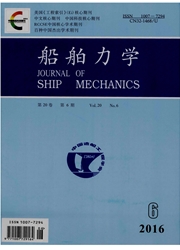

 中文摘要:
中文摘要:
文章采用数值方法对绕水翼的非定常空化流动进行了流动计算,并采用涡动力学方法对非定常空化流场特性进行了分析。计算中,采用基于当地涡旋修正的湍流模型封闭控制方程,通过实验对该计算结果进行验证;采用涡量法分析了空化的发生和发展对涡量输运过程的影响。结果表明:基于当地涡旋修正的湍流模型可以准确地模拟水翼周围非定常空化流场结构;水翼空化流场具有强烈的非定常特性,空化的发展和流场中的涡结构有着紧密的联系;反向射流的作用会导致附着空穴尾缘附近速度梯度的非定常变化,是导致涡量产生和消失的重要因素;空化区域内部水气两相的质量交换会导致流场内体积变化率的变化,使得空化区域内部流体的非正压性显著增强,上述两者导致空化区域内部的涡量分布呈现强烈的非定常特性;空化现象引起的水气两相之间的相互转换以及对湍流的作用都是影响涡结构空间分布的重要因素。
 英文摘要:
英文摘要:
Unsteady cavitating flows around a hydrofoil are calculated. Vortex dynamics are used to ana- lyze the flow structure. Local swirling correction turbulence model is adopted to close the governing equa- tions. Validation of the LSC turbulence model can be reached comparing with experimental results. Vortici- ty transport equations are conducted to analyze the influence of cavitation on vorticity transport process. The results show that: The LSC turbulence model can reflect the influence of the local swirling on cavitating flows well. It can get a good compromise with experimental results. Unsteady cavitation process contains de- veloping of complex vortex structures. Re-entrant jet near trailing of attached cavity leads to distinct changes of velocity gradient, which has great influence on production and dissipation of vorticity. Intensive mass transfer between liquid and vapor phase may induce the volumetric expansion or contraction and baroclinic torque. Two factors mentioned above keep changing and result in unsteady distributions of vorticity. Cavi- tation may lead to unsteady mass and momentum transfers between liquid and vapor phase, which will change turbulence and vorticity distributions distinctly.
 同期刊论文项目
同期刊论文项目
 同项目期刊论文
同项目期刊论文
 期刊信息
期刊信息
